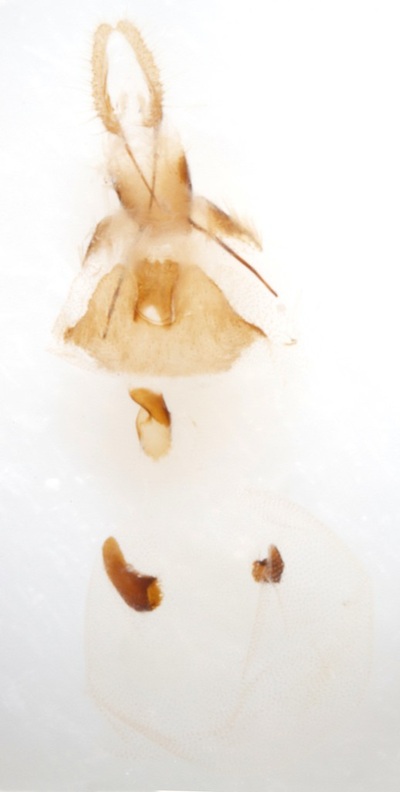49.268 Eucosma parvulana (Saw-wort Tortrix)
ws: 14-19mm; Jul-Aug; saw-wort (Serratula tinctoria); status uncertain - (due to difficulty of distinguishing from E.hohenwartiana)
ID: Very variable in size; in colour from grey-white to white-ochreous; in suffusion with brown, which may obscure the medio-dorsal patch of light ground colour. Distinguished from E.cana by absence of white forewing streaks and generally darker ground colour; and from E.obumbratana by strongly developed costal strigulae in apical half of forewing and again by generally darker ground colour - fulvous in E.obumbratana.
Formerly considered conspecific with E.parvulana and E.fulvana. E.parvulana averages smaller (14-19mm) and has more uniformly coloured forewings. E.fulvana is large (fw 19-25mm) and fulvous. There are no male genital differences between these two species and E.hohenwartiana - they can only be reliably distinguished on the basis of larval foodplant. Dissection group suggests a difference in the dimensions of S8 in the female.
Male genitalia: The valva of E.hohenwartiana is distinguished from E.cana by a longer cucullus with a well-developed lobe, a shorter less robust neck and a more angulate ventral margin to the sacculus; and from E.obumratana by the absence of a pulvinus. (Dissection group comments that a pulvinus is "normally lacking in E.cana and E.hohenwartiana" which implies that it may be present sometimes). See Eucosma for more detail.
Female genitalia: In E.hohenwartiana/parvulana/fulvana the cingulum is fully visible anterior to the subgenital sternite; in all other Eucosma species the cingulum is at least partly covered by the sternite. In E.hohenwartiana the ovipositor (see below) is twice as long as an anterior apophysis; in E.parvulana/fulvana the ovipositor is less than twice as long as an anterior apophysis. In E.hohenwartiana the sterigma is twice as long as broad; in E.parvulana the sterigma is about as long as broad; and in E.fulvana the sterigma is slightly broader than long.
Formerly considered conspecific with E.parvulana and E.fulvana. E.parvulana averages smaller (14-19mm) and has more uniformly coloured forewings. E.fulvana is large (fw 19-25mm) and fulvous. There are no male genital differences between these two species and E.hohenwartiana - they can only be reliably distinguished on the basis of larval foodplant. Dissection group suggests a difference in the dimensions of S8 in the female.
Male genitalia: The valva of E.hohenwartiana is distinguished from E.cana by a longer cucullus with a well-developed lobe, a shorter less robust neck and a more angulate ventral margin to the sacculus; and from E.obumratana by the absence of a pulvinus. (Dissection group comments that a pulvinus is "normally lacking in E.cana and E.hohenwartiana" which implies that it may be present sometimes). See Eucosma for more detail.
Female genitalia: In E.hohenwartiana/parvulana/fulvana the cingulum is fully visible anterior to the subgenital sternite; in all other Eucosma species the cingulum is at least partly covered by the sternite. In E.hohenwartiana the ovipositor (see below) is twice as long as an anterior apophysis; in E.parvulana/fulvana the ovipositor is less than twice as long as an anterior apophysis. In E.hohenwartiana the sterigma is twice as long as broad; in E.parvulana the sterigma is about as long as broad; and in E.fulvana the sterigma is slightly broader than long.

a = length of ovipositor from apex of anal papillae to anterior end of a posterior apophysis
b= length of an anterior apophysis
a/b = 1.82
c = width of sterigma
d = length of sterigma
c/d = 1
b= length of an anterior apophysis
a/b = 1.82
c = width of sterigma
d = length of sterigma
c/d = 1
DIssection
Female genitalia
§1 Folkestone Warren, Kent; 04/07/2013; female; fw 8.1mm
All images © Chris Lewis
All images © Chris Lewis
Page published 21/04/2014 (§1)








